Organisation ESO Collecting area 978 m² | Altitude 3,060 m (10,040 ft) | |
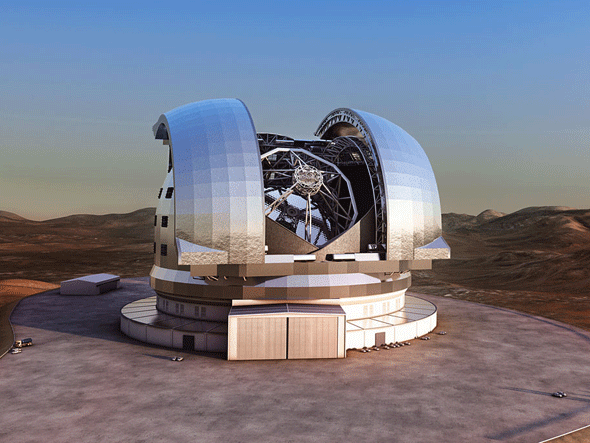 | ||
Location(s) Cerro Armazones, Chile, near Paranal Observatory Weather 89% clear fraction
0.67″ median seeing at 500 nm Wavelength visible, near and mid-infrared Built start: July 2014 (construction)
first light: by 2024 (expected) Organization European Southern Observatory | ||
New european extremely large telescope design unveiled
The European Extremely Large Telescope (E-ELT) is an astronomical observatory and the world's largest optical/near-infrared extremely large telescope now under construction. Part of the European Southern Observatory (ESO), it is located on top of Cerro Armazones in the Atacama Desert of northern Chile. The design comprises a reflecting telescope with a 39.3-metre-diameter (126 foot) segmented primary mirror and a 4.2-metre-diameter secondary mirror, and will be supported by adaptive optics, six laser guide star units and multiple large science instruments. The observatory aims to gather 13 times more light than the largest optical telescopes existing in 2014, and be able to correct for atmospheric distortions. It has around 256 times the light gathering area of the Hubble Space Telescope and, according to the E-ELT's specifications, would provide images 16 times sharper than those from Hubble.
Contents
- New european extremely large telescope design unveiled
- History
- Planning
- Design
- Primary mirror
- Secondary mirror
- Tertiary mirror
- Dome structure
- Astronomical performance
- Windscreen
- Ventilation and air conditioning
- Science goals
- Instrumentation
- Comparison
- Stills
- Comparable instruments
- References
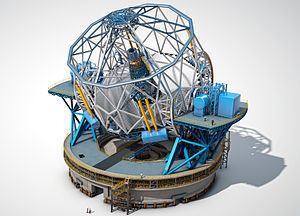
The E-ELT is intended to vastly advance astrophysical knowledge by enabling detailed studies of planets around other stars, the first galaxies in the Universe, super-massive black holes, and the nature of the Universe's dark sector, and to detect water and organic molecules in protoplanetary disks around other stars. The facility is expected to take 11 years to construct.
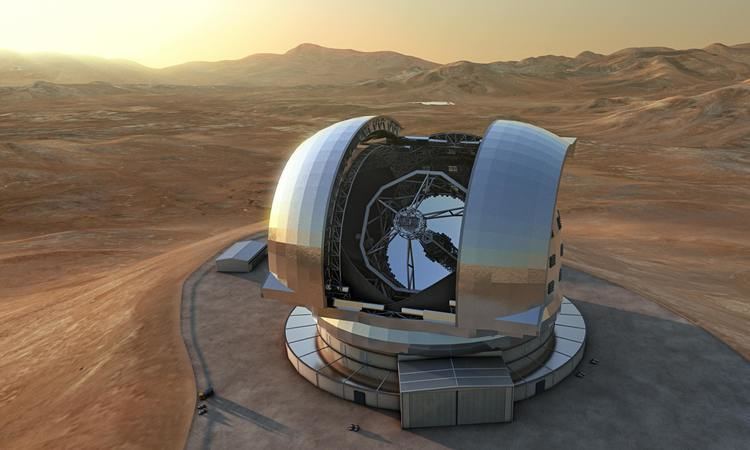
On 11 June 2012, the ESO Council approved the E-ELT programme's plans to begin civil works at the telescope site, with construction of the telescope itself pending final agreement with governments of some member states. Construction work on the E-ELT site started in June 2014. By December 2014, ESO had secured over 90% of the total funding and authorized construction of the telescope to start, which will cost around one billion Euro for the first construction phase. First light is planned for 2024.

History
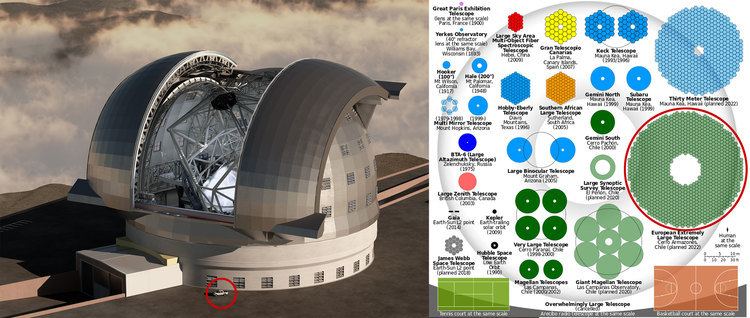
On 26 April 2010, the European Southern Observatory (ESO) Council selected Cerro Armazones, Chile, as the baseline site for the planned E-ELT. Other sites that were under discussion included Cerro Macon, Salta, in Argentina; Roque de los Muchachos Observatory, on the Canary Islands; and sites in South Africa, Morocco, and Antarctica.
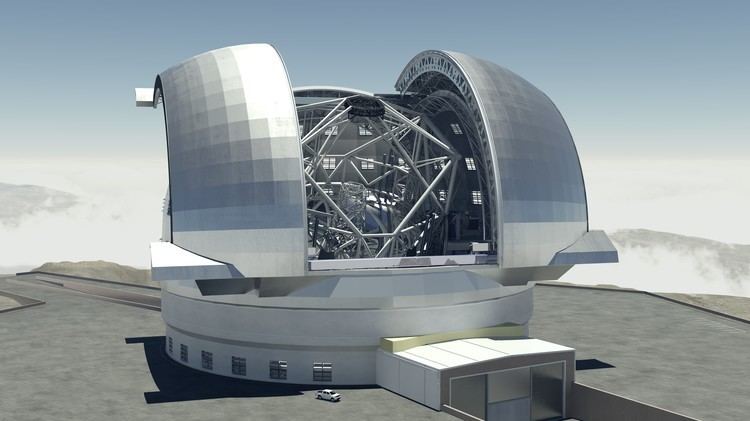
Early designs included a segmented primary mirror with a diameter of 42 metres and area of about 1,300 m2, with a secondary mirror with a diameter of 5.9 m. However, in 2011 a proposal was put forward to reduce its size by 13% to 978 m2, for a 39.3 m diameter primary mirror and a 4.2 m diameter secondary mirror. It reduced projected costs from 1.275 billion to 1.055 billion euros and should allow the telescope to be finished sooner. The smaller secondary is a particularly important change; 4.2 m places it within the capabilities of multiple manufacturers, and the lighter mirror unit avoids the need for high-strength materials in the secondary mirror support spider.

ESO's Director General commented in a 2011 press release that "With the new E-ELT design we can still satisfy the bold science goals and also ensure that the construction can be completed in only 10–11 years." The ESO Council endorsed the revised baseline design in June 2011 and expected a construction proposal for approval in December 2011. Funding was subsequently included in the 2012 budget for initial work to begin in early 2012. The project received preliminary approval in June 2012. ESO approved the start of construction in December 2014, with over 90% funding of the nominal budget secured.
The design phase of the 5-mirror anastigmat was fully funded within the ESO budget. With the 2011 changes in the baseline design (such as a reduction in the size of the primary mirror from 42 m to 39.3 m), the construction cost was estimated to be €1.055 billion (including first generation instruments). The start of operations is planned for 2024.
Planning
The ESO focused on the current design after a feasibility study concluded the proposed 100 metres (330 ft) diameter Overwhelmingly Large Telescope would cost €1.5 billion (£1 billion), and be too complex. Both current fabrication technology and road transportation constraints limit single mirrors to being roughly 8 metres (26 ft) in a single piece. The next-largest telescopes currently in use are the Keck Telescopes, the Gran Telescopio Canarias and the Southern African Large Telescope, which each use hexagonal mirrors fitted together to make a mirror more than 10 metres (33 ft) across. The E-ELT will use a similar design, as well as techniques to work around atmospheric distortion of incoming light, known as adaptive optics.
A 40-metre-class mirror will allow the study of the atmospheres of extrasolar planets. The E-ELT is the highest priority in the European planning activities for research infrastructures, such as the Astronet Science Vision and Infrastructure Roadmap and the ESFRI Roadmap. The telescope underwent a Phase B study in the past couple of years that included "contracts with industry to design and manufacture prototypes of key elements like the primary mirror segments, the adaptive fourth mirror or the mechanical structure (...) [and] concept studies for eight instruments.”
Design
The E-ELT will use a novel design with a total of five mirrors. The first three mirrors are curved (non-spherical), and form a three mirror anastigmat design for excellent image quality over the 10 arcminute field of view. The fourth and fifth mirrors are (almost) flat, and provide adaptive optics correction for atmospheric distortions (mirror 4), and tip-tilt correction for image stabilisation (mirror 5). The fourth and fifth mirrors also send the light sideways to one of the Nasmyth focal stations at either side of the telescope structure, allowing multiple large instruments to be simultaneously mounted.
Primary mirror
The surface of the 39-metre primary mirror will be composed of 798 hexagonal segments. Edge sensors constantly measure the relative positions of the primary mirror segments and their neighbours to ensure that the overall surface shape remains unchanged when the whole assembly is tilted or disturbed by external factors such as wind, temperature changes or vibrations.
In January 2017, ESO awarded the contract for the fabrication of the 4608 edge sensors to the FAMES consortium, which is composed of Fogale and Micro-Epsilon. These sensors can measure relative positions to an accuracy of a few nanometres, the most accurate ever used in a telescope.
Secondary mirror
The secondary mirror is 4.2 metres in diameter and weighs 3.5 tonnes. This will make it the largest secondary ever employed on a telescope and the largest convex mirror ever produced.
Making this mirror is a major challenge as it is both highly convex and aspheric.
In January 2017 ESO awarded a contract to SCHOTT, to cast the mirror from the low-expansion ceramic material Zerodur©. Originally developed for astronomical telescopes in the late 1960s, Zerodur has almost no thermal expansion even in the case of large temperature fluctuations, is highly chemically resistant, and can be polished to a high standard of finish. Many telescopes with Zerodur mirrors have been operating reliably for decades, such as ESO's Very Large Telescope in Chile.
Complex support cells are also necessary to ensure the flexible secondary and tertiary mirrors retain their correct shape and position; these support cells will be provided by the SENER Group.
The pre-formed glass-ceramic blank of the secondary mirror will then be polished, and tested by the French company Reosc, a subsidiary of Safran Electronics & Defense. The mirror will be shaped and polished to a precision of 15 nanometres (15 millionths of a millimetre) over the optical surface.
Tertiary mirror
The 3.8-metre concave tertiary mirror, also cast from Zerodur, will be an unusual feature of the telescope. Most current large telescopes, including the VLT and the NASA/ESA Hubble Space Telescope, use just two curved mirrors to form an image. In these cases a small, flat tertiary mirror is sometimes introduced to divert the light to a convenient focus. However, in the E-ELT the tertiary mirror also has a curved surface, as the use of three mirrors delivers a better final image quality over a larger field of view than would be possible with a two-mirror design.
Dome structure
The E-ELT dome has a height of nearly 74 meters from the ground and 86 meters of diameter, making it the largest dome build for a telescope. For the observing slit, two main designs were under study: one with two sets of nested doors, and the current baseline design, i.e. a single pair of large sliding doors. This pair of doors has a total width of 45.3 m.
Its construction together with the main structure of the telescopes was awarded by the European Southern Observatory to contractors Astaldi and Cimolai and subcontractor EIE. The signature ceremony took place on 25 May 2016 at ESO’s Headquarters in Garching bei München, Germany.
The dome is required to provide protection to the telescope in inclement weather and during the day. A number of concepts for the dome were evaluated. The baseline concept for the 40m-class E-ELT dome is a nearly hemispherical dome, rotating atop a concrete pier, with curved laterally opening doors. This is a re-optimisation from the previous design, aimed at reducing the costs, and it is being revalidated to be ready for construction.
Astronomical performance
In terms of astronomical performance the dome is required to be able to track about the 1-degree zenithal avoidance locus and preset to a new target within the allocated 5 minutes for the preset. This requires the dome to be able to accelerate and move at angular speed of 2 degrees/s (the linear speed is approximately 5 km/h).
The dome is designed to allow complete freedom to the telescope to position itself whether it be opened or closed and to permit observations from zenith down to 20 degrees from the horizon.
Windscreen
With such a large opening, the E-ELT dome requires the presence of a windscreen to protect the telescope primary and other mirrors, other than the secondary, from direct exposure to the wind. The baseline design of the windscreen minimises the volume required to house it. Two spherical blades, either side of the observing slit doors, slide in front of the telescope aperture to restrict the wind.
Ventilation and air-conditioning
The dome design ensures that the dome provides sufficient ventilation for the telescope not to be limited by dome seeing. For this the dome is also equipped with louvers and the windscreen is designed to allow the louvers of the main dome to fulfill their function.
Computational fluid dynamic simulations and wind tunnel work are carried out to study the airflow in and around the dome and the effectiveness of the dome and windscreen in protecting the telescope.
Beside being designed for water-tightness, air tightness is also one of the requirements as it is critical to minimise the air-conditioning load. The air-conditioning of the dome is necessary not only to thermally prepare the telescope for the forthcoming night but also in order to keep the telescope optics clean.
The airconditioning of the telescope during the day has been considered critical and the current specifications permit the dome to cool the telescope and dome internal volume by 10°C during 12 hours.
Science goals
The E-ELT will search for extrasolar planets — planets orbiting other stars. This will include not only the discovery of planets down to Earth-like masses through indirect measurements of the wobbling motion of stars perturbed by the planets that orbit them, but also the direct imaging of larger planets and possibly even the characterisation of their atmospheres. The telescope will attempt to image Earthlike exoplanets, which may be possible.
Furthermore, the E-ELT's suite of instruments will allow astronomers to probe the earliest stages of the formation of planetary systems and to detect water and organic molecules in protoplanetary discs around stars in the making. Thus, the E-ELT will answer fundamental questions regarding planet formation and evolution.
By probing the most distant objects the E-ELT will provide clues to understanding the formation of the first objects that formed: primordial stars, primordial galaxies and black holes and their relationships. Studies of extreme objects like black holes will benefit from the power of the E-ELT to gain more insight into time-dependent phenomena linked with the various processes at play around compact objects.
The E-ELT is designed to make detailed studies of the first galaxies and to follow their evolution through cosmic time. Observations of these early galaxies with the E-ELT will give clues that will help understand how these objects form and evolve. In addition, the E-ELT will be a unique tool for making an inventory of the changing content of the various elements in the Universe with time, and to understand star formation history in galaxies.
One of the goals of the E-ELT is the possibility of making a direct measurement of the acceleration of the Universe's expansion. Such a measurement would have a major impact on our understanding of the Universe. The E-ELT will also search for possible variations in the fundamental physical constants with time. An unambiguous detection of such variations would have far-reaching consequences for our comprehension of the general laws of physics.
Instrumentation
The telescope will have several science instruments. It will be possible to switch from one instrument to another within minutes. The telescope and dome will also be able to change positions on the sky and start a new observation in a very short time.
Eight different instrument concepts and two post-focal adaptive modules are currently being studied, with the aim that two to three will be ready for first light, with the others becoming available at various points over the following decade. The instruments being studied are:
The two post-focal adaptive optics modules currently being studied are:
Comparison
One of the largest optical telescope operating today is the Gran Telescopio Canarias, with a 10.4 m aperture and a light-collecting area of 74 m2. Other planned extremely large telescopes include the 25 m/368 m2 Giant Magellan Telescope and 30 m/655 m2 Thirty Meter Telescope, which are also targeting the beginning of the 2020 decade for completion. These other two telescopes roughly belong to the same next generation of optical ground-based telescopes. Each design is much larger than previous telescopes. Even with the descale to 39.3 m the E-ELT is significantly larger than both other planned extremely large telescopes. It has the aim of observing the Universe in greater detail than the Hubble Space Telescope by taking images 15 times sharper, although it is designed to be complementary to space telescopes, which typically have very limited observing time available. The E-ELT's 4.2-meter secondary mirror is the same size as the primary mirror on the William Herschel Telescope, the second largest optical telescope in Europe.
Stills
The images below show artistic renderings of the E-ELT and were produced by ESO.
